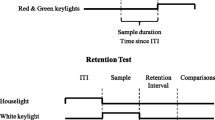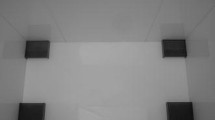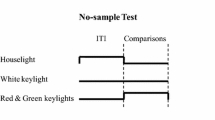Abstract
Time-space learning reflects an ability to represent in memory event-stimulus properties together with the place and time of the event; a capacity well developed in birds. Homing pigeons were trained in an indoor octagonal arena to locate one food goal in the morning and a different food goal in the late afternoon. The goals differed with respect to their angular/directional relationship to an artificial light source located outside the arena. Further, the angular difference in reward position approximated the displacement of the sun's azimuth that would occur during the same time period. The experimental birds quickly learned the task, demonstrating the apparent ease with which birds can adopt an artificial light source to discriminate among alternative spatial responses at different times of the day. However, a novel midday probe session following successful learning revealed that the light source was interpreted as a stable landmark and not as a surrogate sun that would support compass orientation. Probe sessions following a phase shift of the light–dark cycle revealed that the mechanism employed to make the temporal discrimination was prevailingly based on an endogenous circadian rhythm and not an interval timing mechanism.





Similar content being viewed by others
References
Babb SJ, Crystal JD (2005) Discrimination of what, when and where: implications for episodic-like memory in rats. Learn Motiv 36:177–189
Batschelet E (1981) Circular statistics in Biology. Academic, London, UK
Biebach H, Gordijn M, Krebs JR (1989) Time-and-place learning by garden warblers (Sylvia borin). Anim Behav 37:353–360
Biebach H, Falk H, Krebs JR (1991) The effect of constant light and phase shifts on a learned time-place association in garden warblers (Sylvia borin): hourglass or circadian clock? J Biol Rhythms 6:353–365
Biebach H, Krebs JR, Falk H (1994) Time-place learning, food availability and the exploitation of patches in garden warblers, Sylvia borin. Anim Behav 48:273–284
Carr JAR, Tan AO, Wilkie DM (1999) Further evidence that rats use ordinal timing in a daily time-place learning task. Behav Processes 48:35–48
Carr JAR, Wilkie DM (1997) Rats use an ordinal timer in a daily time-place learning task. J Exp Psychol Anim Behav Process 22:232–247
Carr JAR, Tan AO, Thorpe CM, Wilkie DM (2001) Further evidence of joint time-place control of rats behavior: results from an “open hopper” test. Behav Processes 53:147–153
Church RM, Broadbent HA (1990) Alternative representations of time, number, and rate. Cognition 37:55–81
Clayton NS, Dickinson A (1998) Episodic-like memory during cache recovery by scrub jays. Nature 395:272–274
Clayton NS, Dickinson A (1999) Scrub jays (Aphelocoma coerulescens) remember the relative time of caching as well as the location and content of their caches. J Comp Psychol 113:403–416
Emlen ST (1970) Celestial rotation: its importance in the development of migratory orientation. Science 170:1198–1201
Enright JT (1970) Ecological aspects of endogenous rhythmicity. Annu Rev Ecol Syst 1:221–238
Gallistel CR (1990) The organization of learning. MIT Press, Cambridge, MA
Hoffman K (1954) Versuche zu der im Richtungsfinden der Vögel enthaltenen Zeitschätzung. Z Tierpsychol 11:453–475
Koltermann R (1971) 24-Std-Periodik in der Langzeiterinnerung an Duft- und Farbsignale bei der Honigbiene. Z Vergl Physiol 75:49–68
Kramer G, Riese E (1952) Die Dressur von Brieftauben auf Kompassrichtung im Wahlkäfig. Z Tierpsychol 9:24–251
Kramer G (1952) Experiments on bird orientation. Ibis 94:265–285
Lukoyanov NV, Pereira PA, Mesquita RM, Andrade JP (2002) Restricted feeding facilitates time-place learning in adult rats. Behav Brain Res 134:283–290
Means LW, Arolfo MP, Ginn SR, Pence JD, Watson NP (2000a) Rats more readily acquire a time-of-day go no-go discrimination than a time-of-day choice discrimination. Behav Processes 52:11–20
Means LW, Ginn SR, Arolfo MP, Pence JD (2000b) Breakfast in the nook and dinner in the dining room: time-of-day discrimination in rats. Behav Processes 49:21–33
Saksida LM, Wilkie DM (1994) Time-of-day discrimination by pigeons, Columba livia. Anim Learn Behav 22:143–154
Schmidt-König K (1958) Experimentelle Einflussnahme auf die 24-Stunden-Periodik bei Brieftauben und deren Auswirkungen unter besonderer Berücksichtigung des Heimfindevermögens. Z Tierpsychol 15:301–331
Schmidt-König K (1961) Die Sonne als Kompass im Heimorientierungssystem der Brieftauben. Z Tierpsychol 18:221–244
Thorpe CM, Bates ME, Wilkie DM (2003) Rats have trouble associating all three parts of the time-place-memory code. Behav Processes 63:95–110
Wahl O (1932) Neue Untersuchungen uber das Zeitgedächtnis der Bienen. Z vergl Physiol 16:529–589
Wilkie DM, Carr JAR, Galloway J, Parker KJ, Yamamoto A (1996) Some characteristics of spatial associative memory in the pigeon, Columba livia. Behav Processes 38:67–76
Wiltschko W, Balda RP, Jahnel M, Wiltschko R (1999) Sun compass orientation in seed-caching corvids: its role in spatial memory. Anim Cogn 2:215–221
Acknowledgements
This work was generously supported by National Science Foundation grant IBN-0075891 to VPB. We wish to sincerely thank Kevin Pang and Devin McAuley for their helpful criticisms of an earlier draft of this manuscript. All experiments were conducted in accordance with Bowling Green State University animal care and use regulations.
Author information
Authors and Affiliations
Corresponding author
Rights and permissions
About this article
Cite this article
Petruso, E.J., Fuchs, T. & Bingman, V.P. Time-space learning in homing pigeons (Columba livia): orientation to an artificial light source. Anim Cogn 10, 181–188 (2007). https://doi.org/10.1007/s10071-006-0057-0
Received:
Revised:
Accepted:
Published:
Issue Date:
DOI: https://doi.org/10.1007/s10071-006-0057-0




